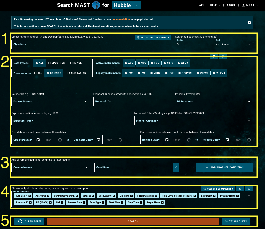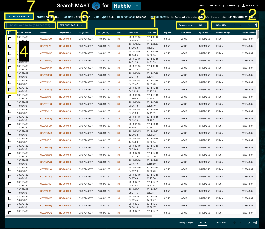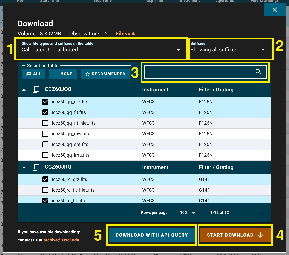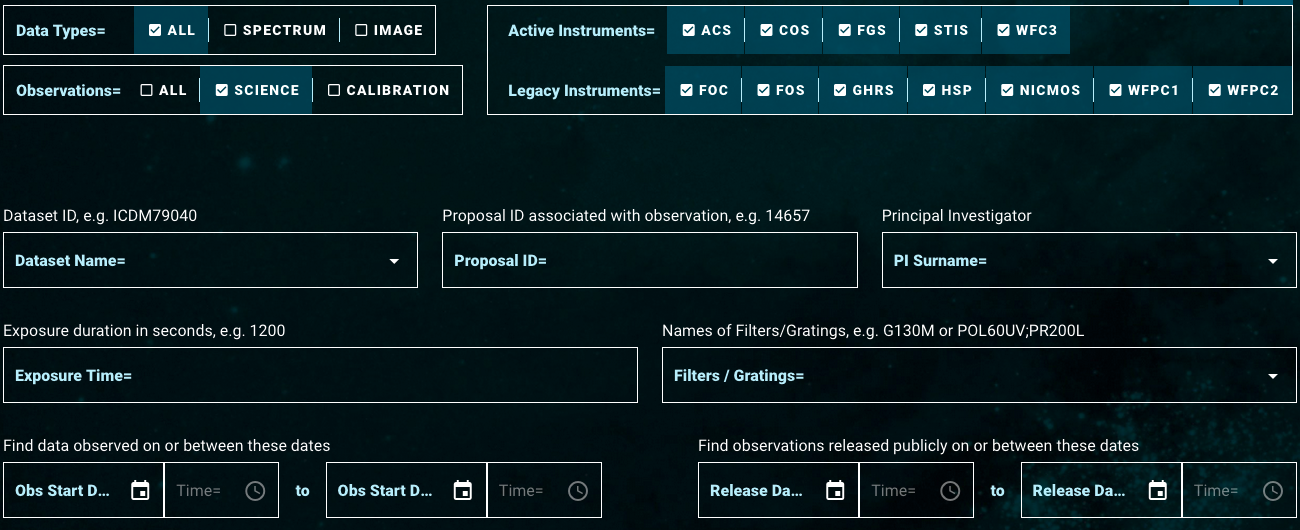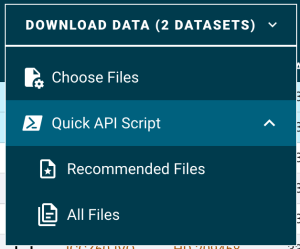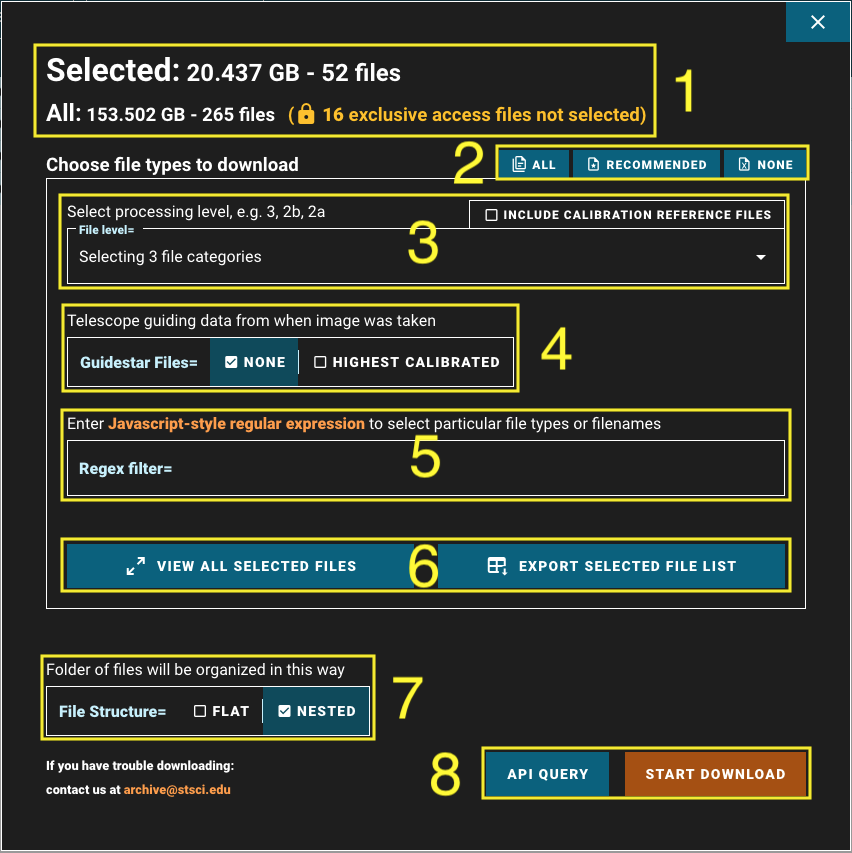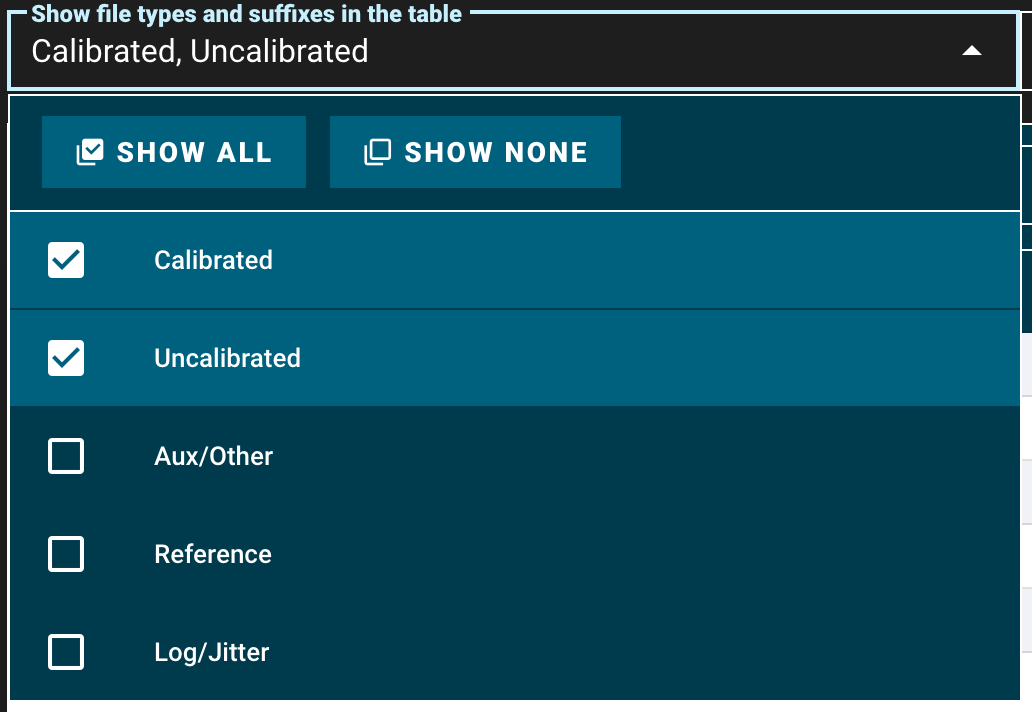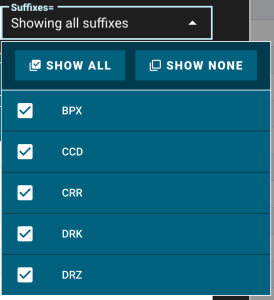Page History
| Excerpt | ||
|---|---|---|
This page provides an overview on how to use the MAST Mission Search to find MAST data collections. The description of each form component on this page is based on the HST search.
|
| Panel | ||||||||
|---|---|---|---|---|---|---|---|---|
| ||||||||
On this page...
|
Major Components Of The Mission Search
This section describes chapter summarizes the field guide to the major components of the Mission Search. There are three main areas: the search form, the search results table, and the download overlay. Each Each numbered box in these figures is described in a corresponding numbered section subsection below.
| borderColor | #00617E |
|---|---|
| bgColor | #E3EEF1 |
| borderWidth | 2 |
| borderStyle | solid |
Search Form
| Anchor |
|---|
|
| Panel | ||||||||
|---|---|---|---|---|---|---|---|---|
|
Download Overlay
Summary Of The Major Components: Search Form
Figure 1 – The Search form window for Hubble, where numbered highlights correspond to areas where various search parameters and constraints are specified, and where searches are initiated. |
The search form is where users specify the search parameters and constraints to create their search. The available
search options include:
Spatial cone search based on coordinates and/or object names,
- Direct search by dataset IDs,
- Advanced search with more specific constraints to narrow the search, and
- Search without specifying any filters. For example,
- Users can search for all observations taken with a particular instrument after a certain date without specifying a specific target.
- Or press 'SEARCH' without entering anything into the form to return every observation taken.
Each field in this search form provides a tooltip as a quick guidance. Users can hover over each field with their mouse to see the tips.
Specific functionality of each component is summarized below.
| borderColor | #00617E |
|---|---|
| bgColor | #E3EEF1 |
| borderWidth | 2 |
1. Cone Search and Upload List Search
Perform a cone search by typing either an object name or the coordinates directly. Multiple object names, coordinates, or combinations of both are allowed by pressing 'return' or 'tab' keys after each object. Use the 'UPLOAD LIST OF TARGETS' button button to upload a comma-separated file containing the object names, coordinates, or specific dataset IDs. Users can set the size of their cone search in arcminutes or arcseconds. This section is not required to conduct a search: users can leave it blank and search based only on other parameters. To start querying, click the Search bar at the bottom of the page.| Note | |
|---|---|
| borderColor | #00617E |
| bgColor | #E3EEF1 | Object names in this component are used only to resolve into coordinates using a name resolver. |
| Panel | |
| 2 |
2.
CoreSearch
ParametersParameter Overview
Use these fields to build advanced searches. Add search constraints based on the most commonly used observation parameters like instrument, proposal information, filter/grating, or start/end times. Each parameter accepts regular expressions, for example, greater than or less than for numerical fields or wildcard characters for string fields. If the default filters on the component do not include the specific parameter needed, see the 'Add Condition'
sectionsection below for further search options
. More info.
panel| borderColor | #00617E |
|---|---|
| bgColor | #E3EEF1 |
| borderWidth | 2 |
3. Add Condition
Use 'Add Condition' to further constrain the search.
SearchSearch for a column based on names and descriptions, or scroll through the complete list in the 'Column Name' text box. The search condition can include numerical constraints or wildcard characters for string fields. Use the 'ADD ANOTHER CONDITION' button to add multiple constraints and columns.
More info.4. Choose Output Columns
Use 'Output Columns' to select which columns to include in the search results. The form is set by default to return a subset recommended by MAST. Use the shortcuts in the upper right to select 'Recommended' (), 'All' (), or 'None'() of the columns. Click in the 'Output Column' box and start typing to search for columns or click the check box in the pop-out menu to select based on its name or description. Remove individual columns from the selected ones by clicking the 'x' next to its name.
More info.| borderColor | #00617E |
|---|---|
| bgColor | #E3EEF1 |
| borderWidth | 2 |
5. The Search Bar
The search bar is always located at the bottom of your screen. Clicking the 'SEARCH' button starts the search. Clicking the 'SHOW API QUERY' button generates a script using the Application Programming Interface (API) for MAST Mission Search, based on the search parameters entered into the form. This can be a great way to learn how to construct queries programmatically. Reset the form using the 'CLEAR FORM' button on the left
. More info.
Search Results Table
| Anchor | ||||
|---|---|---|---|---|
|
| Panel | ||||||||
|---|---|---|---|---|---|---|---|---|
| ||||||||
Figure 2 – The results table after a search for Hubble data. |
The search results table contains observations that match the search parameters. If a list of targets (object names, coordinates, or dataset names along with other information) is uploaded, all uploaded parameters will be included as additional columns in the results table. See the section Cone Search And Upload List Search for valid file formats.
Download Overlay
| Anchor | ||||
|---|---|---|---|---|
|
| Panel | ||||||||
|---|---|---|---|---|---|---|---|---|
| ||||||||
Figure 3 – The download overlay panel, with selectors or action buttons highlighted in numbered boxes. The overlay selectors vary slightly among missions; this graphic applies to JWST. |
Each dataset contains one or more products (i.e., files), including calibration files,
ancillary data, and calibrated
files at various levels of processing. It is possible to download specific file types across the datasets or all the files that are available. The
download overlay allows filtering by product types
, and selection of specific files to download from each dataset. Files that are selected using the checkboxes remain selected to be downloaded even if additional filters are applied in the overlay to make them no longer visible in the overlay.
The selectors and action elements are described in detail in the Download Overlay article.
For Further Reading...
| Panel | ||||||
|---|---|---|---|---|---|---|
| ||||||
| Panel | ||||||
|---|---|---|---|---|---|---|
| ||||||
1. Filter By Product TypesUse this component to show and hide files associated with the selected product types in the file-selection table. Then use checkboxes to select which product rows to mark for download. By default, the table shows all products for all product types, with nothing selected initially. More info. |
| Panel | ||||||
|---|---|---|---|---|---|---|
| ||||||
| Panel | ||||||
|---|---|---|---|---|---|---|
| ||||||
2. Filter By Product SuffixesUse this component to show and hide files by product suffixes. By default, all product suffixes are selected to appear in the file-selection table. More info. |
| Panel | ||||||
|---|---|---|---|---|---|---|
| ||||||
| Panel | ||||||
|---|---|---|---|---|---|---|
| ||||||
3. Filter By String MatchFilter files by typing any string in the search box, which will match against file name, suffix, extension, instrument, or the filter/grating. This search box will only show files that are already visible in the table, so make sure to select all file types and extensions to find specific files. More info. |
| Panel | ||||||
|---|---|---|---|---|---|---|
| ||||||
| Panel | ||||||
|---|---|---|---|---|---|---|
| ||||||
4. Download A Zip File On Your ComputerDownload selected files directly using the 'START DOWNLOAD' button at the bottom of the download overlay window. The files will download as a zip file. The majority of data collections are publicly available, but a small amount is temporarily available for certain people. Downloading non-public datasets requires permission to retrieve those files (granted by the Principal Investigator of each observing program) and logging into your MyST account. For login information, see MAST User Accounts. More info. |
| Panel | ||||||
|---|---|---|---|---|---|---|
| ||||||
| Panel | ||||||
|---|---|---|---|---|---|---|
| ||||||
5. Show API Query to Download Via A ScriptThe 'DOWNLOAD WITH API QUERY' button provides an alternative to downloading the zip file. It allows downloading a script containing terminal commands such as cURL to download the selected files sequentially. This button can also be used to learn how to write a programmatic script to download files. More info. |
